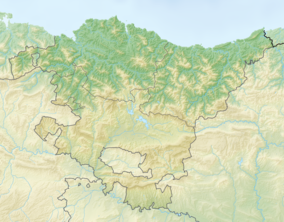The Lagunas de Laguardia (Spanish for 'Lakes of Laguardia', Basque: Guardiako aintzirak) are a wetland complex near Laguardia, Álava, Basque Country, Spain. Three of the lakes (Carravalseca, Carralogroño and Musco) are endorheic seasonal lakes, while the fourth (Prao de la Paúl) is actually a reservoir built at the site of a former wet area.[3] The wetlands were declared a protected biotope by the Basque Government in 1995,[4] they have also been designated a Ramsar wetland and a Natura 2000 site. In 2023 it was reclassified as a nature reserve.[5]
| Lakes of Laguardia Nature Reserve | |
|---|---|
 The Prao de la Paúl reservoir | |
| Location | Laguardia, Álava, Basque Country, Spain |
| Area | 80.57 ha (199.1 acres) |
| Established | 19 September 1995 |
| Designated | 12 September 1996 |
| Reference no. | 880[1] |
| Area | 45 ha (110 acres) |
Natura 2000 site (SAC) | |
| Official name | Guardiako aintzirak / Lagunas de Laguardia |
| Designated | June 2016 |
| Reference no. | ES2110021[2] |
Flora and fauna
editThe margins of the Prao de la Paúl reservoir are covered by helophytes and reeds. There are some hydrophytes present (Persicaria amphibia, Callitriche stagnalis, Polygonum amphibium and Lemna minor), but their extent has been reduced due to the presence of invasive animal species (carps and Louisiana crawifsh). The flora of the endorheic lakes is characterized by its resistance to water level changes, with three species present: Ruppia cirrhosa, Ruppia drepanensis and Chara vulgaris.[6]
When the Prao de la Paúl reservoir was filled, signal crayfish were introduced by the authorities, but this population has probably died off. The Louisiana crawfish was illegally introduced around 1993, it has been deemed an invasive species due to its uncontrollable growth and damage to the local flora. Prao de la Paúl is home to the only fish population of the wetlands, consisting of introduced Eurasian carps and goldfish.[6]
Several amphibian species are present in the lakes, including seven types of frog (Perez's frog, the European tree frog, the common toad, the natterjack toad, Pelobates cultripes, the common midwife toad and the common parsley frog) and the marbled newt. The observed reptile species include Psammodromus algirus, the ocellated lizard, the ladder snake and Malpolon monspessulanus. Additionally, up to 118 different bird species have been observed within a one-year period.[6] The nesting bird species are the little grebe, the common pochard, the water rail, the common moorhen, the Eurasian coot and the mallard.[7]
References
edit- ^ "Lagunas de Laguardia". Ramsar Sites Information Service. Retrieved 11 October 2022.
- ^ "Site factsheet for Guardiako aintzirak / Lagunas de Laguardia". EUNIS. European Environment Agency. Retrieved 14 October 2022.
- ^ Nicolás, Jesús (20 August 2022). "La laguna grande de Laguardia tendrá una isla artificial el próximo invierno". El Correo (in Spanish). Retrieved 11 October 2022.
- ^ "DECRETO 417/1995, de 19 de septiembre, por el que se declara Biotopo Protegido las lagunas de Carralogroño, Carravalseca y Prao de la Paul en Laguardia" (PDF). BOPV (in Spanish and Basque) (201): 12132–12139. 20 October 1995.
- ^ "ORDEN de 20 de marzo de 2023, de la Consejera de Desarrollo Económico, Sostenibilidad y Medio Ambiente, por la que se aprueba la adaptación de la denominación de los biotopos protegidos de la Comunidad Autónoma del País Vasco" (PDF). BOPV (in Spanish) (60). 27 March 2023. ISSN 2483-5374.
- ^ a b c Documento de información ecológica, objetivos de conservación, normas para la conservación y programa de seguimiento para la designación de la Zona Especial de Conservación (ZEC) Lagunas de Laguardia ES2110021 (PDF). euskadi.eus (Report) (in Spanish). Dirección de Medio Natural y Planificación Ambiental. April 2015. pp. 15–21. Retrieved 11 October 2022.
- ^ Lagunas de laguardia (PDF). Euskal Mendizale Federazioa (Report) (in Spanish). Sistema de Información de Biodiversidad. p. 7. Retrieved 11 October 2022.
External links
edit- Media related to Lagunas de Laguardia at Wikimedia Commons
- Official website
- Geographic data related to Lagunas de Laguardia at OpenStreetMap

